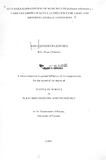| dc.description.abstract | This study aimed at quantifying total glycoalkaloids, characterizing and quantifying a-chaconine and a-solanine of promising potato clones and varieties grown in Kenya. These compounds were studied with a view of ascertaining whether their contents varied with the potato types, changes in storage temperature and light exposure. It has been established that high levels (20mg/100g Fwt) of these compounds are toxic to animals and human and may change with storage and harvesting conditions.
Freeze-dried materials of potato clones and varieties were extracted in a mixture of THF/HbO/acetonitrile or acetic acid for HPLC and titration with bromophenol blue, respectively. This was repeated for the tubers that were exposed to fluorescent tube (36W/54, 2500 lumens) and sunlight and those that were stored under ambient temperature and fridge conditions. The HPLC samples were ultrafiltered with a 0.45pm membrane before they were fractionated in a Nucleosil NH2 column at a flow rate of lmm/min and detected at 208nm and compared with pure standards of solanidine, a-chaconine, and a-solanine.
The results indicated that a-chaconine, a-solanine and solanidine were present in most varieties and CIP clones in significant quantities (5%). The elution patterns for the compounds were consistent. These patterns resulted in concentrations of total glycoalkaloids, a-chaconine and a-sol'anine of 3.50mg to 15.97mg/100g Fwt, 1.62mg to 4.46mg/100g Fwt, and 2.24mg to 6.41mg/100g Fwt, respectively, for the potato varieties, and 6.31mg to 17.48mg/100g Fwt, 2.24mg to 6.41mg/100g Fwt and 2.27mg to 3.80mg/100g Fwt, respectively, for the clones. The lowest and highest TGA values were recorded in Dutch Robyjn (3.50mg/100g Fwt) and Tigoni (15.97mg/100g Fwt). The results showed a significant-cultivar dependent variation in the glycoalkaloid contents.
The overall difference between the light storage and controls was significant at 5% level. The variety x light interactions for the contents were highly significant for TGA, a-chaconine, a- solanine contents. It significantly increased closer to the safety limits in some varieties that were exposed to sunlight. The results show that light can stimulate the synthesis of glycoalkaloids to levels above the safe limit (20mg/100g Fwt).
The effect of storage temperature on a-chaconine and a-solanine content was significant at the 5% level. The values of a-chaconine and a-solanine for the tubers stored under ambient room temperature ranged from 2.41mg to 5.07mg/100g Fwt and 1.85mg to 4.54mg/100g Fwt, respectively. The amount of these compounds for the potato tubers stored in the fridge varied from 2.06mg to 4.93mg/100g Fwt and 1.92mg to 4.06mg/100g Fwt, respectively. It is, therefore, suggested that storage at low temperature may greatly limit the synthesis of glycoalkaloids.
The glycoalkaloid contents in fresh tubers of the present commercial potato varieties and CIP clones are within the upper safety limit of 20mg/100g Fwt. Thus, the study demonstrates that no significant build-up in glycoalkaloids takes place under fridge and ambient temperature conditions. From these results, it is apparent that there is need to ensure that TGA, a-chaconine and a-solanine contents are maintained within the maximum limits under varying storage conditions of temperature and light. Any factors such as high light intensity and temperature that induce the contents to rise above 20mg/100g Fwt need to be controlled in order to limit the build-up of toxicity levels of TGA,
a-chaconine and a-solanine. | en_US |



